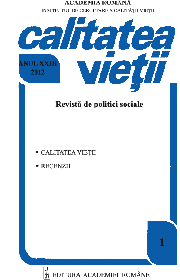Economia socială şi cooperația în România. O perspectivă socioistorică comparată
Social economy and cooperation sector in Romania. A comparative socio-historical perspective
Author(s): Maria LarionescuSubject(s): Social Sciences
Published by: Editura Academiei Române
Keywords: social economy; pre-modern cooperation; modern cooperation; social entrepreneurs; traditional cooperative resourses; cooperation normative frame; cooperation typology; cooperation autonomy; administrative tutelage on cooperation
Summary/Abstract: This article is based on research conducted within the program POSDRU 2007–2013, Prometeus – Promoting Social Economy în Romania through Research, Education and Professional Formation at the European Standards. The inquiry offers what we consider to be the first synthesis of the evolution of Romanian cooperatives from the perspective of social economy. The article presents relevant information for understanding and explaining the conditions that facilitated both successes and failures of rural and urban cooperatives in Romania. The study reveals an unprecedented aspect of cooperatives precursors associated to the premodern trade and with the precursors of the merchants that operate on the capitalist market, the fact that they had a fundamental moral resource: the mutual trust of the stakeholder partners. The capitalist merchants involved in mass trade that would eventually form a consistent part of the Romanian cooperative members would have been rather interested to gain money, to surpass the problems of the competition, than to cultivate with priority the principles of honesty, fair play, mutual trust, as part of the professional ethos. Thus, a moral resource indispensable to business, part of the moral profile of the cooperative stakeholders, available in the practice of the middle class precursors, was no longer as resuscitated and converted into social capital of the merchants and manufacturers confronting on the free market, being partly lost on the way. The precarious state of agricultural productivity was a poor source of expansion for the cooperative associations. The most visible expression of the absence of major stimulants for the development of the cooperative movement in agriculture was the presence of an explosive germ within the rural social structure where over 80% of the active population worked: the absolute majority (51.1%) of the auxiliary members of the families of agricultural workers and the relative majority consisting of the self-employed small agricultural workers (34.3%). The practice of subsistence agriculture within a family system with an active population overwhelmingly consisting of the family members that are helping the household head to perform a primate exploitation of the land drastically limited the opportunities to build and consolidate a vigorous cooperative movement. We discuss arguments presented by recognized experts concerning the identity of cooperatives as an institution of social economy: its finalities, relations between the normative state and the cooperative autonomy, types and frequencies of cooperative units, levels of participation of village and urban population to the cooperative movement. The article proposes a starting point for a debate concerning cooperation in relation to the dynamic of population needs, comparing cooperative politics versus real associative life, in the problematic context of social economy. We question the links between credit cooperations, economic (production)...
Journal: Calitatea vieţii
- Issue Year: XXIV/2013
- Issue No: 2
- Page Range: 109-136
- Page Count: 28
- Language: Romanian

